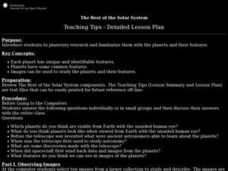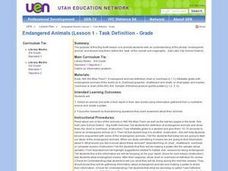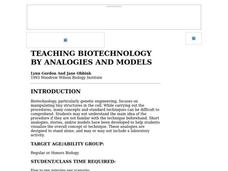Curated OER
The Lorax
Students read The Lorax and discuss how human actions can affect the environment. They conduct a simple experiment to see how much air pollution is in the air that they breathe.
Curated OER
The Best of the Solar System (Grades 6-8)
Learners are introduced to planetary research and become familiar with the planets and their features. They view images of the planets, and fill in an information chart which is imbedded in this plan.
Curated OER
Endangered Animals (Lesson 1 - Task Definition - Grade 3)
Third graders use The Big Six to gain an understanding of the phrase 'endangered animal.' They select an animal, research it and write a report about it. They also make a poster of the animal.
Curated OER
Lemon Light
Learners engage in a lesson which model different types of light refraction. They perform an experiment which uses lasers, jello and wax paper to illustrate how light refracts.
Curated OER
The Internal Anatomy of the Grasshopper
Sixth graders explore the internal organs of grasshoppers. They determine the function of the organs through a dissection activity.
TryEngineering
Here Comes the Sun
Students explore concept of how solar energy is gathered by solar panels and adapted to provide power to machines, disassemble solar powered calculator and explore component parts, and work in teams to suggest design enhancements to the...
Curated OER
Spiders are Special
First graders recognize that spiders are important natural predators. They work in small groups with simple field guides to identify as many of their spiders as they can.
Curated OER
Transcription, Translation, and the Genetics of Microbes
Students construct various virus models using Fruit loops and Alphabits to represent nucleotides and molecules. They constructs capsomeres using shoes as the capsomeres and discuss various viruses.
Curated OER
DNA and Individual Differences
Students list differences between DNA-related terms and create a simple DNA circle map. They order terms including human body, organ, tissue, cell, nucleus, etc. from largest to smallest. They discuss differences and similarities among...
Curated OER
Genome's Greatest Hits
Students explore the progression of discoveries that have led to the genetics knowledge that scientists currently have. In groups, students research scientists that have made important contributions to understanding the molecules behind...
Curated OER
Clay Hill Animal Sampling
Students create animal print casts from molds in the classroom. They use the cast patterns to identify animal prints on a field trip in which they locate animal tracks, identify the location with GPS and create field casts of the...
Curated OER
Water Under the Bridge
Students consider how much water they use on daily basis by investigating and recording their own patterns of water use over two weeks, and discover ways to begin conserving water in their own homes. Culminating field trip to local creek...
Curated OER
Teaching Biotechnology By Analogies And Models
Students explore biotechnology by analogies and models. They read several provided scenarios and answer questions to discover some basic concepts of biotechnology.
Curated OER
Elegant Embryology
Students observe embryogenesis in action through early stages of development of eggs. They observe cultures with dissecting and compound microscopes. They draw their egg, record any details and observe for changes. They compare their...
Curated OER
Evolution: Natural Selection
Learners analyze and discuss the evolutionary history of dinosaurs. In this investigative lesson students monitor different organisms in the environment and analyze the pressures that affect the chances of survival.
Curated OER
Rights or Fights
High schoolers identify and explain the four doctrines of groundwater use law. Students compare and contrast the doctrines of groundwater use law; High schoolers also research and decide on a groundwater case based on the groundwater...
Curated OER
Cypress/Tupelo Swamps
Young scholars study the geologic history of terrain, soils, and drainage patterns. They recognize ecological processes that determine the dynamic nature of habitats. They investigate the influence of human activity on the landscape.
Curated OER
Acid-Base Indicator Paper
Middle schoolers are able to prepare and use pH indicators in paper form. They find out the color of the indicator paper plus test solution may change with time. Students use red cabbage to use for the indicator.
Curated OER
Sour Acids and Bitter Bases
Pupils explore acids and bases. They experience the sour taste of acids and the bitter taste of bases by tasting substances such as chocolate, lemon juice, and baking soda. in addition, they complete a worksheet for individual assessment.
Curated OER
Activity #7 Mass, Volume and Density
Students comprehend that density depends on the type of material and not on the amount of material. They use a spoonfl of table salt and a box of table salt and have the same density. Pupils comprehend that density is calculated by...
Curated OER
Liquids Have Differnt Viscosities
Students explore visosity of matter. They run tests of various liquid substances to observe and compare rates of flow of different substances. In addition, they relate viscosity to distance travelled by sample substances.
Curated OER
Condensation and the Water Cycle
Students explore the natural distallation process that occurs in the water cycle. They use plastic cups and cotton swabs to observe the condensation process that is evident in the water cycle.
Curated OER
Activity #5 Environmental Effects
Pupils explain the implications of particle theory of The Law of Conservation of Matter for problems of pollution and waste disposal. They describe, in terms of atoms and molecules, what happens to materials when they are dissolved or...
Curated OER
Constellations
Middle schoolers explore the major constellations. After reviewing the Earth's basic motions and their significance, students discuss the moon's orbit and revolutions. Using a Digitarium Alpha portable planetarium projector, they...

























